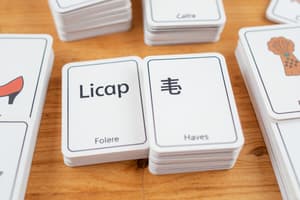Podcast
Questions and Answers
Which key researchers studied the capacity of Short-Term Memory (STM)?
Which key researchers studied the capacity of Short-Term Memory (STM)?
Miller (Immediate Digit Span Test) and Jacobs provided supporting evidence.
Describe Peterson and Peterson's study on the duration of Short-Term Memory (STM).
Describe Peterson and Peterson's study on the duration of Short-Term Memory (STM).
24 students were asked to recall a consonant syllable (e.g., THX) after a retention interval of 3, 6, 9, 12, or 18 seconds, during which they counted backward from a three-digit number. Recall was 90% after 3 seconds, 20% after 9 seconds, and 2% after 18 seconds.
How did Bahrick investigate the duration of Long-Term Memory (LTM)?
How did Bahrick investigate the duration of Long-Term Memory (LTM)?
Bahrick tested 400 people on their memory of high school classmates using free recall, photo recognition, and name recognition tests. Photo recognition accuracy was 90% after 15 years and 70% after 48 years. Free recall was 60% after 15 years and 30% after 48 years.
What did Baddeley's study on encoding reveal about STM and LTM?
What did Baddeley's study on encoding reveal about STM and LTM?
What is the estimated capacity of Short-Term Memory (STM) according to Miller?
What is the estimated capacity of Short-Term Memory (STM) according to Miller?
What is the estimated capacity of Long-Term Memory (LTM)?
What is the estimated capacity of Long-Term Memory (LTM)?
What is the estimated duration of Short-Term Memory (STM) without rehearsal?
What is the estimated duration of Short-Term Memory (STM) without rehearsal?
What is the estimated duration of Long-Term Memory (LTM)?
What is the estimated duration of Long-Term Memory (LTM)?
How is information primarily encoded in Short-Term Memory (STM) according to Baddeley?
How is information primarily encoded in Short-Term Memory (STM) according to Baddeley?
How is information primarily encoded in Long-Term Memory (LTM) according to Baddeley?
How is information primarily encoded in Long-Term Memory (LTM) according to Baddeley?
Describe the sequence of stores in the Multi-Store Model (MSM) of memory.
Describe the sequence of stores in the Multi-Store Model (MSM) of memory.
What are the key suggestions of the Multi-Store Model (MSM) of memory?
What are the key suggestions of the Multi-Store Model (MSM) of memory?
What evidence supports the Multi-Store Model (MSM) of memory?
What evidence supports the Multi-Store Model (MSM) of memory?
Briefly evaluate the Multi-Store Model (MSM) of memory.
Briefly evaluate the Multi-Store Model (MSM) of memory.
What is the main suggestion of the Working Memory Model (WMM)?
What is the main suggestion of the Working Memory Model (WMM)?
According to the WMM, what is the function of the Central Executive?
According to the WMM, what is the function of the Central Executive?
According to the WMM, what is the role of the Phonological Loop?
According to the WMM, what is the role of the Phonological Loop?
What are the two sub-stores of the Phonological Loop in the WMM?
What are the two sub-stores of the Phonological Loop in the WMM?
According to the WMM, what is the function of the Visuo-Spatial Sketchpad?
According to the WMM, what is the function of the Visuo-Spatial Sketchpad?
What are the two proposed components of the Visuo-Spatial Sketchpad?
What are the two proposed components of the Visuo-Spatial Sketchpad?
According to the WMM (updated version), what is the role of the Episodic Buffer?
According to the WMM (updated version), what is the role of the Episodic Buffer?
What evidence supports the Working Memory Model (WMM)?
What evidence supports the Working Memory Model (WMM)?
Briefly evaluate the Working Memory Model (WMM).
Briefly evaluate the Working Memory Model (WMM).
What are the three main types of Long-Term Memory (LTM) proposed by Tulving?
What are the three main types of Long-Term Memory (LTM) proposed by Tulving?
What are the two types of interference that can explain forgetting?
What are the two types of interference that can explain forgetting?
Provide evidence for proactive and retroactive interference.
Provide evidence for proactive and retroactive interference.
What is retrieval failure?
What is retrieval failure?
What is the encoding specificity principle, and what evidence supports it?
What is the encoding specificity principle, and what evidence supports it?
What is context-dependent forgetting, and what evidence supports it?
What is context-dependent forgetting, and what evidence supports it?
What is state-dependent forgetting, and what evidence supports it?
What is state-dependent forgetting, and what evidence supports it?
What factors can affect the accuracy of Eyewitness Testimony (EWT)?
What factors can affect the accuracy of Eyewitness Testimony (EWT)?
Describe Loftus and Palmer's study on leading questions and Eyewitness Testimony (EWT).
Describe Loftus and Palmer's study on leading questions and Eyewitness Testimony (EWT).
What is post-event discussion, and how can it affect EWT (provide evidence)?
What is post-event discussion, and how can it affect EWT (provide evidence)?
Describe Johnson & Scott's study investigating the effect of anxiety on EWT (weapon focus effect).
Describe Johnson & Scott's study investigating the effect of anxiety on EWT (weapon focus effect).
Provide evidence suggesting anxiety can sometimes improve EWT accuracy.
Provide evidence suggesting anxiety can sometimes improve EWT accuracy.
How can the contradictory findings on anxiety's effect on EWT be explained?
How can the contradictory findings on anxiety's effect on EWT be explained?
What does the Yerkes-Dodson Law propose regarding arousal and performance?
What does the Yerkes-Dodson Law propose regarding arousal and performance?
What alternative explanation exists for the weapon focus effect, besides anxiety?
What alternative explanation exists for the weapon focus effect, besides anxiety?
What are the main techniques used in a Cognitive Interview (CI)?
What are the main techniques used in a Cognitive Interview (CI)?
Evaluate the effectiveness of the Cognitive Interview (CI).
Evaluate the effectiveness of the Cognitive Interview (CI).
What are some limitations of a Standard Interview compared to a Cognitive Interview?
What are some limitations of a Standard Interview compared to a Cognitive Interview?
Flashcards
Capacity of STM studies
Capacity of STM studies
Testing capacity of STM. Studies include Miller's Immediate Digit Span Test and Jacobs' research, providing support for STM's limited capacity.
Duration of STM study
Duration of STM study
Peterson and Peterson (Trigrams). Participants recalled consonant syllables after intervals of 3-18 seconds while counting backwards. Recall dropped significantly, suggesting STM duration is less than 18 seconds.
Duration of LTM study
Duration of LTM study
Bahrick (Yearbook Photos). Tested memory of high school classmates using free recall, photo recognition, and name recognition. Photo recognition was 90% accurate after 15 years and 70% after 48 years, suggesting potentially unlimited LTM duration.
Encoding of STM/LTM study
Encoding of STM/LTM study
Signup and view all the flashcards
STM Capacity
STM Capacity
Signup and view all the flashcards
LTM Capacity
LTM Capacity
Signup and view all the flashcards
STM Duration
STM Duration
Signup and view all the flashcards
LTM Duration
LTM Duration
Signup and view all the flashcards
STM Encoding
STM Encoding
Signup and view all the flashcards
LTM Encoding
LTM Encoding
Signup and view all the flashcards
Multi-Store Model (MSM)
Multi-Store Model (MSM)
Signup and view all the flashcards
MSM Explanation
MSM Explanation
Signup and view all the flashcards
Evidence Supporting MSM
Evidence Supporting MSM
Signup and view all the flashcards
Evaluation of MSM
Evaluation of MSM
Signup and view all the flashcards
Working Memory Model (WMM)
Working Memory Model (WMM)
Signup and view all the flashcards
Central Executive (CE)
Central Executive (CE)
Signup and view all the flashcards
Phonological Loop
Phonological Loop
Signup and view all the flashcards
Parts of Phonological Loop
Parts of Phonological Loop
Signup and view all the flashcards
Visuo-Spatial Sketchpad
Visuo-Spatial Sketchpad
Signup and view all the flashcards
Parts of Visuo-Spatial Sketchpad
Parts of Visuo-Spatial Sketchpad
Signup and view all the flashcards
Episodic Buffer
Episodic Buffer
Signup and view all the flashcards
Evidence for WMM
Evidence for WMM
Signup and view all the flashcards
Evaluation of WMM
Evaluation of WMM
Signup and view all the flashcards
Types of LTM
Types of LTM
Signup and view all the flashcards
Interference Types
Interference Types
Signup and view all the flashcards
Evidence for Interference
Evidence for Interference
Signup and view all the flashcards
Retrieval Failure
Retrieval Failure
Signup and view all the flashcards
Encoding Specificity Principle
Encoding Specificity Principle
Signup and view all the flashcards
Context-Dependent Forgetting
Context-Dependent Forgetting
Signup and view all the flashcards
State-Dependent Forgetting
State-Dependent Forgetting
Signup and view all the flashcards
Factors Affecting EWT
Factors Affecting EWT
Signup and view all the flashcards
Loftus and Palmer Study
Loftus and Palmer Study
Signup and view all the flashcards
Post-Event Discussion
Post-Event Discussion
Signup and view all the flashcards
Johnson & Scott WFE
Johnson & Scott WFE
Signup and view all the flashcards
Anxiety Improves Memory
Anxiety Improves Memory
Signup and view all the flashcards
Yerkes-Dodson Law
Yerkes-Dodson Law
Signup and view all the flashcards
Surprise, not Anxiety?
Surprise, not Anxiety?
Signup and view all the flashcards
Cognitive Interview (CI)
Cognitive Interview (CI)
Signup and view all the flashcards
Evaluate the CI
Evaluate the CI
Signup and view all the flashcards
Limits of Standard Interview
Limits of Standard Interview
Signup and view all the flashcards
Study Notes
- Study notes on memory, covering capacity, duration, encoding, models of memory, forgetting, eyewitness testimony (EWT), and cognitive interviews (CI).
Study of STM Capacity
- Miller's Immediate Digit Span Test and Jacobs' research supports the idea of limited STM capacity.
Study of STM Duration
- Peterson and Peterson used trigrams to show STM duration is short.
- Participants recalled consonant syllables after intervals of 3, 6, 9, 12, or 15 seconds while counting backwards from a 3-digit number.
- Recall accuracy dropped from 90% at 3 seconds to 2% at 18 seconds, suggesting STM duration is less than 18 seconds.
Study of LTM Duration
- Bahrick's study tested memory of high school classmates.
- Participants completed free recall, photo recognition, and name recognition tasks.
- Photo recognition accuracy was 90% after 15 years and 70% after 48 years.
- Free recall accuracy was 60% after 15 years and 30% after 48 years.
- Results suggest LTM has a potentially unlimited duration
Study of Encoding
- Baddeley used semantically/acoustically similar/dissimilar words.
- Participants struggled with acoustically similar words in STM and semantically similar words in LTM.
- STM is primarily encoded acoustically, while LTM is encoded semantically as a result.
Capacity of STM
- STM has a capacity of 7 +/- 2 units.
Capacity of LTM
- LTM has a potentially unlimited capacity.
Duration of STM
- STM has a duration of approximately 30 seconds.
Duration of LTM
- LTM has a potentially unlimited duration.
Encoding in STM
- STM is mainly encoded acoustically.
Encoding in LTM
- LTM is mainly encoded semantically.
Multi-Store Model (MSM)
- MSM suggests memory flows from sensory memory to STM via attention, then to LTM via elaborative rehearsal.
- Maintenance rehearsal in STM can keep information there, forgetting occurs through retrieval failure, interference, or decay.
What the MSM Model Suggests
- Memory consists of multiple stores, involving a sequence between these stores to explain memory.
Evidence to Support the MSM
- Glanzer and Cunnitz's primacy and recency effect, HM (impaired LTM), Beardsley (prefrontal cortex for STM, hippocampus for LTM).
- Bahrick, Peterson and Peterson, Miller, Baddeley all provide supporting evidence for the MSM model.
Evaluation of the MSM
- The model's simplicity is both a strength (easy to understand) and a weakness (oversimplified).
- There is supporting evidence for the MSM Model.
Working Memory Model (WMM)
- WMM proposes that STM consists of multiple stores, suggesting MSM is too simple
Central Executive
- The central executive directs attention to tasks and controls the phonological loop and visuo-spatial sketchpad.
Phonological Loop
- The phonological loop processes and retains the order of heard information.
- It is divided into the phonological store (inner ear) and the articulatory process (inner voice).
Phonological Loop Subdivisions
- Phonological store (stores heard information, inner ear).
- Articulatory process (subvocal repetition, inner voice)
Visuo-Spatial Sketchpad
- The visuo-spatial sketchpad plans spatial tasks and stores visual or spatial information.
Visuo-Spatial Sketchpad Subdivisions
- Visual cache (visual information).
- Inner scribe (processes spatial relations).
Episodic Buffer
- The episodic buffer integrates information from all other STM stores.
Evidence for the WMM
- Hitch and Baddeley's dual-task experiments and KF's case (verbal impaired, visual fine).
Evaluation of the WMM
- The model lacks evidence for the central executive.
- There is supporting evidence for separate STM stores (Hitch and Baddeley).
- Lieberman suggests dividing the visuo-spatial sketchpad into separate visual and spatial components, as spatial awareness isn't always visual
Types of LTM
- Episodic memories: personal experiences/events.
- Procedural memories: how to do things, acquired through repetition.
- Semantic memories: facts and knowledge, often transitioning from episodic memories.
Interference Theory
- Proactive interference: old information interferes with new information.
- Retroactive interference: new information interferes with old information.
Evidence for Interference Theory
- Proactive interference: Underwood's meta-analysis showed later word lists are harder to learn due to earlier lists. After memorizing 10+ lists, recall after 24 hours was low.
- Retroactive interference: Muller's study gave participants a list of nonsense syllables to learn and recall, intervening tasks decreased recall.
- Rugby players forgetting earlier games due to new games.
Retrieval Failure
- Retrieval failure occurs due to the absence of cues, suggesting cues are needed to recall information.
- Cues act as reminders by having a meaningful link or environmental cue to a memory.
Encoding Specificity Principle
- Cues should be close to the original encoded information to aid retrieval.
- A study involving word category recall found that providing category cues at recall (60%) improved recall compared to free recall (40%).
Context-Dependent Forgetting
- The context during learning acts as a cue, and its absence hinders retrieval.
- Godden and Baddeley's scuba diver study found recall was better when the learning and recall environments matched (land or underwater).
State-Dependent Forgetting
- The mental state during learning acts as a cue.
- Goodwin's study found recall was better when participants were in the same state (drunk or sober) during learning and recall.
Factors Affecting Eyewitness Testimony (EWT) Accuracy
- Age, anxiety, leading questions, post-event discussion.
Leading Questions and EWT
- Loftus and Palmer's car crash study used different verbs (smashed, collided, bumped, hit, contacted) in questions about speed.
- The verb "smashed" led to higher speed estimates.
- Participants in the "smashed" condition were more likely to falsely remember seeing broken glass.
Post-Event Discussion
- Memory can be altered by discussing events with others.
- Gabbert's study found that witnesses who discussed the event made more mistakes in recall.
Anxiety and EWT Study
- Johnson & Scott's weapon focus effect: participants saw a man with either a pen (low anxiety) or a knife (high anxiety).
- Identification accuracy was lower in the knife condition (high anxiety).
Positive Effect of Anxiety on Accuracy
- Evolutionary explanation: remembering emotionally important events is adaptive.
- A study of bank robbery witnesses found that those with higher anxiety (victims) recalled more than those with lower anxiety (bystanders).
Resolution of Anxiety Effect on EWT
- A psychologist reviewed 21 studies and found contradictory evidence, which led to developing the Yerkes-Dodson effect.
Yerkes-Dodson Law
- EWT accuracy increases with anxiety to an optimal point, then declines.
Limitations for Weapon Focus Being Caused by Anxiety
- Weapon focus may be caused by surprise, not anxiety.
- A study found that identification of a suspect was lowest in high-surprise conditions (raw chicken).
Cognitive Interview (CI) Techniques
- MRCC: mental reinstatement of original context, report everything, change order, change perspective.
- Mental reinstatement allows for emotional and contextual cues.
- Reporting everything triggers bigger memories and pieces smaller things together.
- Changing order/perspective removes schemas.
Evaluation of CI
- A meta-analysis of 53 studies found a 34% increase in correct information with CI.
- Kohnken's study found CI increased correct information (81%) and incorrect information (61%); police must handle information carefully.
- CI requires time, which police officers may lack
Limitations of a Standard Interview
- Standard interviews use close-ended questions.
- Standard Interviews do not maximize recall.
- Brief questions elicit facts.
- Witness concentration broken by interruptions as a result.
Studying That Suits You
Use AI to generate personalized quizzes and flashcards to suit your learning preferences.




